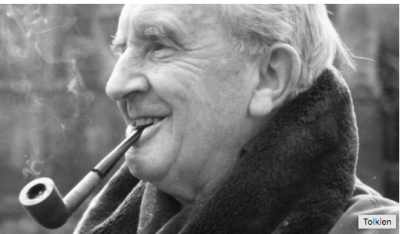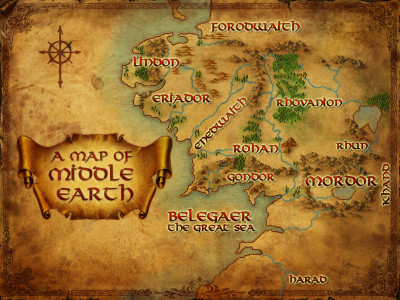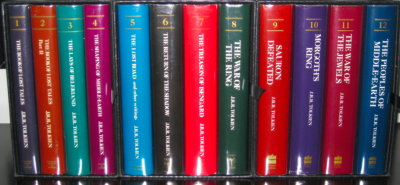Article 5: JRR Tolkien on “Sub-creation” and Fairy Stories
February 18, 2016
Tristan Stone explores how Tolkien’s essay on Fairy Stories and his notions of sub-creation and mythopoeia help solve some of the problems of metaphysical language.
Tolkien on ‘Sub-creation’ and Fairy Stories
In his essay, On Fairy-Stories JRR Tolkien distinguishes fairy stories from being merely about fairies (a narrow definition encompassing merely those creatures of “diminutive size”) in fairy of stories “about Fairy, that is Faërie, the realm or state in which fairies have their being. Faërie contains many things besides elves and fairies, and besides dwarfs, witches, trolls, giants, or dragons: it hold the seas, the sun, the moon, the sky and the earth and all things that are in it: tree and bird, water and stone, wine and bread and ourselves, mortal men, when we are enchanted.” (p14) Is this enchantment wholly mythological or metaphorical?

Tolkien suggests that “we encounter [fairies/elves] only at some chance crossing of the ways.” And in a footnote says “this is true also, even if they are only creations of Man’s mind, ‘true’ only as reflecting in a particular way on of Man’s vision of Truth.” His capitalisation is interesting and perhaps it reveals Tolkien’s sense of realism. A reality that is accessed best by the imaginal.
“Faërie cannot be caught in a net of words; for it is one of its qualities to be indescribable, though not imperceptible.” Here Tolkien recognises the limits of language to describe reality. We meet reality in a realm beyond words and where words fail us we sub-create. Mythopoeia (Myth-making) is where it’s at.
Although we cannot know in full and we cannot thus describe, it does not render the supernatural unintelligible. We CAN speak of God – and not merely in the negative. This is what myth most enables us to do, and, in this regard, fantasy fiction is a re-mythologising of eternal truths.
“Invention, Inheritance and Diffusion, have evidently played their part in producing the intricate web of Story.” (pg23) This is Sub-creation. Yet, for Tolkien, “the incarnate mind, the tongue, and the tale are in our world coeval” [ie of the same age]. It is difficult to distinguish from whence the myth was diffused or translated (such as the myth of the dying and rising god). There is a hint here at the universal which is bound in the particular. Further, Tolkien points out the mistake of dismissing mythological stories on the basis that they occur elsewhere. It may be that a particular instance is historical but we must test this on its own merits.

Fantasy
Tolkien draws a distinction between imagination and fancy / fantasy. He calls this world the “primary world” and perhaps we shall agree because it is the world we appear to first experience. But it is, of course, the later world – the shadow world. And it is later because it is created and born from the Mind of God. “The the images are of things not in the primary world (if that indeed is possible) is a virtue not a vice. Fantasy, (in this sense) is, I think, not a lower but a higher form of Art, indeed the most nearly pure form, and so (when achieved) the most potent.”
“FANTASY IS A RATIONAL NOT AN IRRATIONAL ACTIVITY”: [p45n]
Unfortunately, for Tolkien, Fantasy “too often, remains undeveloped; it is and has been used frivolously, or only half-seriously, or merely for decoration: it remains merely ‘fanciful’.”
(Presumably why he spent so long on the languages and histories of Middle Earth!)
Incidentally, Tolkien dislikes the witches in Macbeth. But someone suggests this is because he is not of the time. If we thought witches were possible in the Primary World we’d accept them in the story?
Tolkien dislikes drama as it presents a secondary world and in so doing creates a tertiary world “a world too much” He thinks this is to misunderstand story making. For Tolkien, “Fantasy is a natural human activity. It certainly does not destroy or even insult Reason…on the contrary. The keener and the clearer is the reason, the better fantasy will it make.”
Sub-creation a right
It is our right, according to Tolkein to be subcreators, “we make in our measure and in our derivative mode, because we are made: and not only made, but made in the image and likeness of a Maker”. Thus we see once again the origin is ever from above. We speak because we are spoken to. We love because we are loved. (cf 1 John 4:19 “We love Him, because He first loved us.”) For “all things come from you, and of your own do we give you.”
EuCatastrophe
As Tragedy is, for Tolkien, the true form of Drama, so the Happy ending is of Fairy Story. This he calls eucatastrophe “the eucatastrophic tae is the true form of the fairy-tale, and its highest function.” (p62). In this, the fairy story (whilst admitting that bad things may, can, and even sometimes must happen) “denies (in the fact of much evidence, if you will) universal final defeat and in so far is evangelium, giving a fleeting glimpse of Joy, Joy beyond the walls of the world, poignant as grief.” YES!! In this way, Fairy Stories are truer than any story because it is an answer the the problem of evil -” all shall be well” IT is GOSPEL (good news). This sudden turn, for Tolkien, gives us “a piercing glimpse of joy, and heart’s desire, that for a moment passes outside the frame, rends indeed the very web of story, and lets a gleam come through.”
He goes on to explain that “the peculiar quality of the ‘joy’ in successful Fantasy can thus be explained as a sudden glimpse of the underlying reality” (p65)
This is of course the fairy story that is the Gospel. “But this story has entered History and the primary world; the desire and aspiration of sub-creation has been raised to the fulfilment of Creation. The Birth of Christ is the eucatastrophe of Man’s history. The Resurrection is the eucatastrophe of the Incarnation. This story begins and ends in joy. It has pre-eminently the ‘ineer consistency of reality. There is no tale ever told that men would rather find was true, and non which so many sceptical men have accepted as true on its own merits. For the Art of it has the supremely convincing tone of Primary Art, that is, of Creation. To reject it leads either to sadness or to wrath.”
Finally, in this story, “Art has been verified.”
Implications for Religious Language
The idea of Sub-creation helps us solve some problems with religious language (or, rather, metaphysical language – since religious language, strictly speaking, deals with the rituals and practice of faith, not its object). Where Aquinas notes that we know God “by His operations,” our role as sub-creators enables to empathise (though dimly) with the Divine in His activity as Creator. It is, of course, analogous and yet again demonstrates at once the difficulty in escaping anthropomorphism (which is to make God in our image) and the image of God that we are made in. Thus in understanding the relationship between us and the creatures of our sub-creation, we are able to say more about God.
Further, the activity of the imaginal – seeing beyond what our senses perceive – is the very start of metaphysics (literally, above – or beyond – physics). It is, then, in our sub-creative activity that we defeat the “ugly fact” and come to glean more of the Truth beyond.
Tolkien called this imaginal activity of myth-making “mythopoeia” and wrote a poem to his young atheist friend, CS Lewis who once postured that myths were untrue.
from Mythopoeia by JRR Tolkien
To one [C.S. Lewis] who said that myths were lies and therefore worthless, even though ‘breathed through silver’.
The heart of Man is not compound of lies,
but draws some wisdom from the only Wise,
and still recalls him. Though now long estranged,
Man is not wholly lost nor wholly changed.
Dis-graced he may be, yet is not dethroned,
and keeps the rags of lordship once he owned,
his world-dominion by creative act:
not his to worship the great Artefact,
Man, Sub-creator, the refracted light
through whom is splintered from a single White
to many hues, and endlessly combined
in living shapes that move from mind to mind.
Though all the crannies of the world we filled
with Elves and Goblins, though we dared to build
Gods and their houses out of dark and light,
and sowed the seed of dragons, ’twas our right
(used or misused). The right has not decayed.
We make still by the law in which we’re made.
Yes! ‘wish-fulfilment dreams’ we spin to cheat
our timid hearts and ugly Fact defeat!
Whence came the wish, and whence the power to dream,
or some things fair and others ugly deem?
All wishes are not idle, nor in vain
fulfilment we devise — for pain is pain,
not for itself to be desired, but ill;
or else to strive or to subdue the will
alike were graceless; and of Evil this
alone is deadly certain: Evil is.
Blessed are the legend-makers with their rhyme
of things not found within recorded time.
It is not they that have forgot the Night,
or bid us flee to organized delight,
in lotus-isles of economic bliss
forswearing souls to gain a Circe-kiss
(and counterfeit at that, machine-produced,
bogus seduction of the twice-seduced).
Such isles they saw afar, and ones more fair,
and those that hear them yet may yet beware.
They have seen Death and ultimate defeat,
and yet they would not in despair retreat,
but oft to victory have tuned the lyre
and kindled hearts with legendary fire,
illuminating Now and dark Hath-been
with light of suns as yet by no man seen.







0 Comments